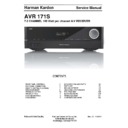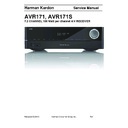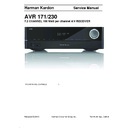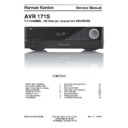Harman Kardon AVR 171S (serv.man3) Service Manual ▷ View online
ENGLISH
AVR
Front-Panel Controls
Front-Panel Controls, continued
Power indicator/Power button: The AVR has three different power modes:
Off (Power indicator glows solid amber): The Off mode minimizes energy consumption
Ř
when you’re not using the AVR. When the AVR is off, it will not automatically turn on
or play audio in response to an AirPlay stream from a networked device (AVR 1710/
AVR 171 only). When the AVR is off, pressing the Power button turns it on. To turn
the AVR off when it is on, press the Power button for more than three seconds. The
Front-Panel Display will indicate “Your device is switched off” for two seconds, then
will switch off.
or play audio in response to an AirPlay stream from a networked device (AVR 1710/
AVR 171 only). When the AVR is off, pressing the Power button turns it on. To turn
the AVR off when it is on, press the Power button for more than three seconds. The
Front-Panel Display will indicate “Your device is switched off” for two seconds, then
will switch off.
NOTE: You can use the System Setup menu to set the AVR to automatically enter
the off mode after it has been in the Sleep mode for a certain period of time. See
System Settings, on page 34.
the off mode after it has been in the Sleep mode for a certain period of time. See
System Settings, on page 34.
Sleep
Ř
(Power indicator glows solid amber and front-panel display indicates “Device
sleep”): The Sleep mode powers-down some of the AVR’s circuitry, but allows the
AVR to automatically turn on and play audio in response to an AirPlay or DLNA
DMR stream from a networked device (AVR 1710/AVR 171 only). When the AVR is
in Sleep, pressing the Power button turns it on. To put the AVR into Sleep when it is
on, press the Power button for less than three seconds. The front-panel display will
indicate “Device sleep” while the AVR is in the Sleep mode.
AVR to automatically turn on and play audio in response to an AirPlay or DLNA
DMR stream from a networked device (AVR 1710/AVR 171 only). When the AVR is
in Sleep, pressing the Power button turns it on. To put the AVR into Sleep when it is
on, press the Power button for less than three seconds. The front-panel display will
indicate “Device sleep” while the AVR is in the Sleep mode.
NOTE: The AVR will automatically enter the Sleep mode after 30 minutes of no audio
signal or user control input , unless USB, iPod, Home Network, vTuner, AirPlay, or
DLNA DMR is active. In these cases, the AVR will automatically enter the Sleep mode
after the number of hours set in the Auto Power Off system setting. See System
Settings, on page 34.
signal or user control input , unless USB, iPod, Home Network, vTuner, AirPlay, or
DLNA DMR is active. In these cases, the AVR will automatically enter the Sleep mode
after the number of hours set in the Auto Power Off system setting. See System
Settings, on page 34.
On
Ř
(Power indicator glows solid white): When the AVR is on it is fully operational.
Headphone jack/EzSet/EQ Mic input: Connect a 1/4” stereo headphone plug to this
jack for private listening. This jack is also used to connect the supplied microphone for
the EzSet/EQ setup procedure described in Configure the AVR For Your Speakers, on
page 22.
jack for private listening. This jack is also used to connect the supplied microphone for
the EzSet/EQ setup procedure described in Configure the AVR For Your Speakers, on
page 22.
Tuning Mode button (AVR 1710/AVR 1610 only): Press this button to toggle the radio
between the manual (one frequency step at a time) and automatic (seeks frequencies
with acceptable signal strength) FM tuning mode. The button also toggles the radio
between stereo and mono modes when an FM station is tuned in.
between the manual (one frequency step at a time) and automatic (seeks frequencies
with acceptable signal strength) FM tuning mode. The button also toggles the radio
between stereo and mono modes when an FM station is tuned in.
RDS button (AVR 171/AVR 161 only): When listening to an FM radio station that
broadcasts RDS information, this button activates the various RDS functions.
broadcasts RDS information, this button activates the various RDS functions.
USB port: The USB port can be used to play audio files from an Apple iOS
®
device
connected to the port, and can also be used to play MP3 and WMA audio files from a USB
device inserted into the port. Insert the connector or device into the USB port oriented so
it fits all the way into the port. You may insert or remove the connector or device at any
time – there is no installation or ejection procedure.
device inserted into the port. Insert the connector or device into the USB port oriented so
it fits all the way into the port. You may insert or remove the connector or device at any
time – there is no installation or ejection procedure.
You can also use the USB port to perform firmware upgrades. If an upgrade for the AVR’s
operating system is released in the future, you will be able to download it to the AVR
using this port. Complete instructions will be provided at that time.
operating system is released in the future, you will be able to download it to the AVR
using this port. Complete instructions will be provided at that time.
IMPORTANT: Do not connect a PC or other USB host/controller to this port, or you
may damage both the AVR and the other device.
may damage both the AVR and the other device.
Channel Volume Adjust button: Press this button to activate the individual channel
level adjustment. After pressing this button, use the Up/Down buttons/Tuning buttons to
select the channel for adjustment and use theLeft/Right buttons to adjust the channel’s
level.
level adjustment. After pressing this button, use the Up/Down buttons/Tuning buttons to
select the channel for adjustment and use theLeft/Right buttons to adjust the channel’s
level.
Audio Input button: Press this button to change the audio input connection for the current
source. Use the Left/Right buttons to cycle through the available input connections, and
press the Set button to assign the currently-displayed connection to the source.
source. Use the Left/Right buttons to cycle through the available input connections, and
press the Set button to assign the currently-displayed connection to the source.
IR sensor: This sensor receives infrared (IR) commands from the remote control. Make
sure that the sensor is not blocked.
sure that the sensor is not blocked.
Set button: Press this button to select the currently highlighted menu item.
Left/Right buttons: Use these buttons to navigate the AVR’s menus.
Front-panel display: Various messages appear on this two-line display in response to
commands and changes in the incoming signal. In normal operation, the current source
name appears on the upper line, while the active surround mode is displayed on the
lower line. When the on-screen display menu system (OSD) is in use, the current menu
settings appear.
commands and changes in the incoming signal. In normal operation, the current source
name appears on the upper line, while the active surround mode is displayed on the
lower line. When the on-screen display menu system (OSD) is in use, the current menu
settings appear.
Up/Down buttons/Tuning buttons: Use these buttons to navigate the AVR’s menus.
When the radio is the active source, use these buttons to tune stations according to the
setting of the Tuning Mode button (see above).
When the radio is the active source, use these buttons to tune stations according to the
setting of the Tuning Mode button (see above).
Surround Mode Category button: Press this button to select a surround-sound
category. Each press changes the surround-mode category: Auto Select, Virtual, Stereo,
HARMAN NSP, Movie, Music and Video Game. To change the specific surround-sound
mode within the category, use the Surround Mode Select buttons. See Audio Processing
and Surround Sound, on page 29, for more information about surround modes.
category. Each press changes the surround-mode category: Auto Select, Virtual, Stereo,
HARMAN NSP, Movie, Music and Video Game. To change the specific surround-sound
mode within the category, use the Surround Mode Select buttons. See Audio Processing
and Surround Sound, on page 29, for more information about surround modes.
Surround Mode Select buttons: After you have selected the desired surround-mode
category, press these buttons to select a specific mode within the category, such as to
change from Dolby
category, press these buttons to select a specific mode within the category, such as to
change from Dolby
®
Pro Logic
®
II Movie mode to DTS
®
NEO:6 Cinema mode. Surround
mode availability depends on the nature of the source input signal, i.e., digital versus
analog, and the number of channels encoded within the signal.
analog, and the number of channels encoded within the signal.
Source Select buttons: Press these buttons to select the active source.
Volume knob: Turn this knob to raise or lower the volume.
5
Harman Kardon
$
Page 4 of 174
Rear-Panel Connectors
6
Rear-Panel Connectors
HDMI/MHL Input
Connector
Connector
HDMI Input
Connectors
Power Cord
(AVR 1710)
HDMI Output
Connectors
Analog Video
Connectors
AVR 1710/AVR 171
Subwoofer
Pre-Out
Connectors
Radio Antenna
Connectors
Digital Audio
Connectors
Fan Vents
Speaker
Connectors
Network
Connector
AC Input
Connector (AVR 171)
Connector (AVR 171)
IR and Trigger
Connectors
Connectors
Analog Audio
Connectors
HDMI/MHL Input
Connector
Connector
HDMI Input
Connectors
Power Cord
(AVR 1610)
HDMI Output
Connector
Analog Video
Connectors
AVR 1610/AVR 161
Subwoofer
Pre-Out
Connector
Radio Antenna
Connectors
Digital Audio
Connectors
Speaker
Connectors
Network
Connector
AC Input
Connector
(AVR 161)
IR and Trigger
Connectors
Analog Audio
Connectors
Harman Kardon
Page 5 of 174
ENGLISH
AVR
Rear-Panel Connectors
7
Rear-Panel Connectors, continued
Digital Audio connectors: If your non-HDMI source devices have digital outputs,
connect them to the AVR’s digital audio connectors. NOTE: Make only one type of digital
connection (HDMI, optical or coaxial) from each device. See Connect Your Audio and Video
Source Devices, on page 16, for more information.
connect them to the AVR’s digital audio connectors. NOTE: Make only one type of digital
connection (HDMI, optical or coaxial) from each device. See Connect Your Audio and Video
Source Devices, on page 16, for more information.
Radio Antenna connectors: Connect the supplied AM and FM antennas to their
respective terminals for radio reception.
respective terminals for radio reception.
Analog Audio connectors: The following analog audio connectors are provided:
Analog Audio Input connectors:
t
Use the AVR’s Analog Audio Input connectors for
source devices that don’t have HDMI or digital audio connectors. See Connect Your
Audio and Video Source Devices, on page 16, for more information.
Audio and Video Source Devices, on page 16, for more information.
Zone 2 Out connectors (AVR 1710/AVR 171 only):
t
Connect these jacks to an
external amplifier to power the speakers in the remote zone of a multizone system.
Network connector: If your home network is wired, use a Cat. 5 or Cat. 5E Ethernet
cable (not supplied) to connect the AVR’s Network connector to your home network to
enjoy Internet radio and content from DLNA-compatible devices that are connected to the
network. See Connect to Your Home Network, on page 18, for more information.
cable (not supplied) to connect the AVR’s Network connector to your home network to
enjoy Internet radio and content from DLNA-compatible devices that are connected to the
network. See Connect to Your Home Network, on page 18, for more information.
Subwoofer Pre-Out connector: Connect this jack to a powered subwoofer with a line-
level input. See Connect Your Subwoofer, on page 15, for more information. NOTE: The
AVR 1710 and AVR 171 have two subwoofer connectors.
level input. See Connect Your Subwoofer, on page 15, for more information. NOTE: The
AVR 1710 and AVR 171 have two subwoofer connectors.
HDMI Output connectors: If your TV has an HDMI connector and you are connecting
HDMI source devices to the AVR, use an HDMI cable (not included) to connect it to
the AVR’s HDMI Out connector. NOTE: The AVR 1710 and AVR 171 have two HDMI Out
connectors.
HDMI source devices to the AVR, use an HDMI cable (not included) to connect it to
the AVR’s HDMI Out connector. NOTE: The AVR 1710 and AVR 171 have two HDMI Out
connectors.
Notes on using the HDMI Output connector:
When connecting a DVI-equipped display to the HDMI Out connector, use an
Ř
HDMI-to-DVI adapter and make a separate audio connection.
Make sure the HDMI-equipped display is HDCP (High-bandwidth Digital Content
Ř
Protection)-compliant. If it isn’t, do not connect it via an HDMI connection; use an
analog video connection instead and make a separate audio connection.
analog video connection instead and make a separate audio connection.
AVR 1710/AVR 171 only: If you have connected a 3D-capable TV to HDMI Out 1
Ř
and a 2D-capable TV to HDMI Out 2, the AVR will not allow 3D playback when
both TVs are powered on. To watch 3D content, turn off the AVR and both TVs,
then first turn on the 3D TV, then turn on the AVR, and finally turn on the 3D
source device. Do NOT turn the 2D TV back on.
both TVs are powered on. To watch 3D content, turn off the AVR and both TVs,
then first turn on the 3D TV, then turn on the AVR, and finally turn on the 3D
source device. Do NOT turn the 2D TV back on.
HDMI/MHL Input connector: If you have a Roku Streaming Stick or other MHL-capable
device, connect it only to this HDMI/MHL In connector. If you do not have an MHL device
you can use this connector for an HDMI-capable device.
device, connect it only to this HDMI/MHL In connector. If you do not have an MHL device
you can use this connector for an HDMI-capable device.
Speaker connectors: Use two-conductor speaker wire to connect each set of terminals
to the correct speaker. See Connect Your Speakers, on page 14, for more information.
to the correct speaker. See Connect Your Speakers, on page 14, for more information.
NOTE: The Assigned Amp speaker connectors (AVR 1710/AVR 171 only) are used
for the surround back or Front Height channels in a 7.1- channel home theater, or
you can reassign them to a remote room for multizone operation or to front height
channels for Dolby
for the surround back or Front Height channels in a 7.1- channel home theater, or
you can reassign them to a remote room for multizone operation or to front height
channels for Dolby
®
Pro Logic IIz operation. See Place Your Speakers, on page 11,
for more information.
Analog Video connectors: The following Analog Video connectors are provided:
Composite Video Input connectors:
t
Use composite video connectors for video
source devices that don’t have HDMI connectors. You will also need to make an
audio connection from the source device to the AVR. See Connect Your Audio and
Video Source Devices, on page 16, for more information.
audio connection from the source device to the AVR. See Connect Your Audio and
Video Source Devices, on page 16, for more information.
Composite Video Monitor Out connector:
t
If your TV or video display does not
have an HDMI connector, or if your TV does have an HDMI connector but you are
connecting some source devices with only composite video connectors, use a
composite video cable (not included) to connect the AVR’s Composite Video Monitor
Out connector to your TV ’s composite video input.
connecting some source devices with only composite video connectors, use a
composite video cable (not included) to connect the AVR’s Composite Video Monitor
Out connector to your TV ’s composite video input.
HDMI
®
Input connectors: An HDMI connection transmits digital audio and video signals
between devices. If your source devices have HDMI connectors, using them will provide
the best possible video and audio performance quality. Since the HDMI cable carries
both digital video and digital audio signals, you do not have to make any additional audio
connections for devices you connect via the HDMI connection. See Connect Your Audio
and Video Source Devices, on page 16, for more information.
the best possible video and audio performance quality. Since the HDMI cable carries
both digital video and digital audio signals, you do not have to make any additional audio
connections for devices you connect via the HDMI connection. See Connect Your Audio
and Video Source Devices, on page 16, for more information.
IR and Trigger connector: The following IR and trigger connectors are provided:
IR In connectors:
t
When the IR sensor on the front panel is blocked (such as when
the AVR is installed inside a cabinet), connect an optional IR receiver to the IR In
jack.
jack.
12V Trigger connector:
t
This connector provides 12V DC whenever the AVR is on. It
can be used to turn on and off other devices such as a powered subwoofer.
Zone 2 IR Input connector (AVR 1710/AVR 171 only):
t
Connect a remote IR
receiver located in Zone 2 of a multizone system to this jack to control the AVR from
the remote zone.
the remote zone.
Fan Vents (AVR 1710/AVR 171 only): These vents are used by the AVR’s fan to cool the
system. Maintain a clearance of at least three inches (75mm) from the nearest surface to
avoid overheating the unit. It is normal for the fan to remain off at most normal volume
levels. An automatic temperature sensor turns the fan on only when it is needed.
system. Maintain a clearance of at least three inches (75mm) from the nearest surface to
avoid overheating the unit. It is normal for the fan to remain off at most normal volume
levels. An automatic temperature sensor turns the fan on only when it is needed.
IMPORTANT NOTE: Never block the fan vents. Doing so could allow the AVR to
overheat to dangerous levels.
overheat to dangerous levels.
AC Input connector (AVR 171/AVR 161 only): After you have made and verified all
other connections, plug the supplied AC power cord into this receptacle and into an
unswitched wall outlet.
other connections, plug the supplied AC power cord into this receptacle and into an
unswitched wall outlet.
Power cord (AVR 1710/AVR 1610 only): After you have made and verified all other
connections, plug the power cord into an unswitched wall outlet.
connections, plug the power cord into an unswitched wall outlet.
Harman Kardon
Page 6 of 174
AVR
System Remote Control Functions
8
System Remote Control Functions
Source Selector Buttons
Power Off Button
Power On Button
Back/Exit Button
Volume Up/Down Buttons
Mute Button
Zone 2 Button
(AVR 1710/AVR 171 only)
(AVR 1710/AVR 171 only)
Home Button
AVR Button
OK Button
Clear Button
Delay Button
IR Transmitter
Surround Modes Button
Number Buttons
Test Tone Button
OSD/Menu Button
Sleep Button
Display Dimmer Button
Memory Button
RDS Button
Previous Channel Button
Transport Control Buttons
Info/Option Button
Direct Button
Preset Scan Button
Channel/Tuner Buttons
Up/Down/Left/Right
Buttons
Buttons
Harman Kardon
Page 7 of 174




